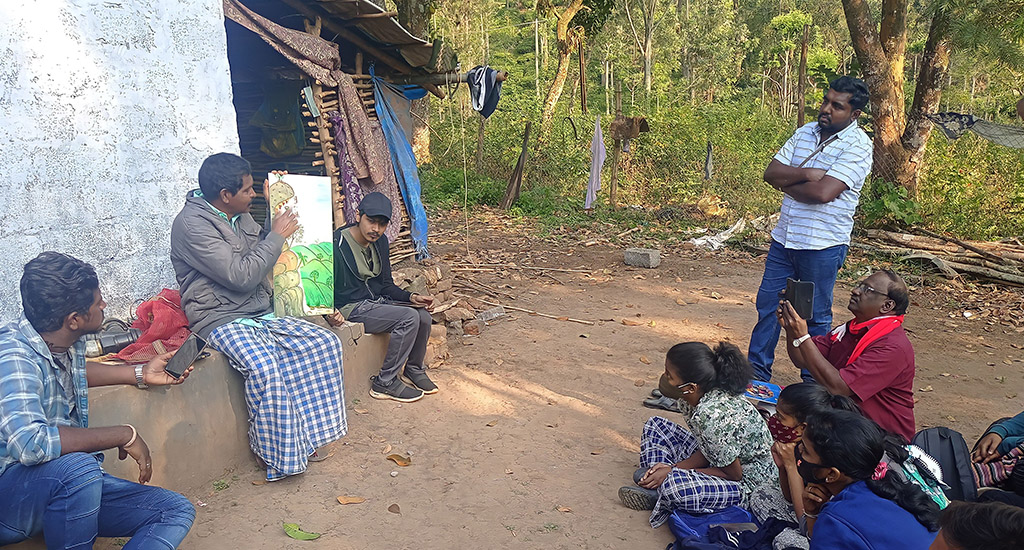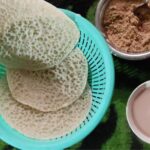Eluthu Paarai is an ancient 3000-year-old rock art site in the Kothagiri region of the Nilgiris district that was first discovered by an American anthropologist, Allen Zackerel, in 1984. Archaeologists maintain that they are definitely prehistoric, belonging to the Neolithic period in particular.
However, the local Kurumba tribe believes that this ancient art is the holy message of their ancestors.
Why?
Because they used to draw similar pictographs on the body of the patients with an incurable disease.
Moreover, the Alu Kurumbas are observed to venerate the ‘anthropomorphic figure’ of that site as their ‘ancestral spirit’ and believe that it could be revitalised by annual re-touching or re-drawing the ritual cult figure.
What is Alu Kurumba art?
Alu Kurumbas’ paintings mostly depict ritualistic aspects of their way of life in the Nilgiris’ isolated forests.

Images of nature, homes made of leaves and wood, women drying food grains, men gathering honey, weddings and rituals, earthen pens for hens, wild animals prowling the forest are just a few of the themes featured in this wonderful style of art.
Also Read | An ancient art is earning modern dividends in Khasi Hills
The paintings are natural. They are drawn with burned twigs and traditionally done with four colours using an extracted resin. Bodhi mann soil is used for red and white colours, while kari maram’s tree bark is used for black and the leaves of kaatavarai plant for green.
The aerial root of the banyan tree is used as a painting brush.
It is a slow and cumbersome process but the end results are beautiful paintings depicting the Alu Kurumbas’ way of life.
A shift in culture
Traditionally Alu Kurumbas are hunter gatherers and horticulturists who primarily depend on their environment for livelihood.
When they were cultivating their staple food crops such as finger millet, little millet, foxtail millet, pearl millet, and pulses like cowpeas, they were largely self-sufficient.

Various government interventions in the form of policies and welfare schemes have led to the alienation of nature from the life of Alu Kurumbas.
Initially the forests near their villages were largely converted into coffee and tea plantations and the Alu Kurumbas ended up working as labours in those plantations.
The sudden shift from agricultural land owner to plantation worker has distorted the way the Alu Kurumbas interact with their land.
The sudden shift from agricultural land owner to plantation worker has distorted the way the Alu Kurumbas interact with their land.
One man’s effort at preserving the Alu Kurumba art
The change in the pattern of interaction between man and nature has also resulted in a change in their culture.
Also Read | “With the Bhil Pithora art, I let my creativity run free”
Though Alu Kurumbas are known to draw inspiration from their personal lives, the current generation hardly practices their traditional art.

During the time of my visit, I learnt that only one person, Balasubramanian, in the settlement was practicing their traditional art. (ALSO READ: Keeping Kurumba art alive)
He has been taking immense efforts to kindle an interest in the younger generation towards the Alu Kurumba art by teaching them the basics of the art and by buying them fabric paints.
One hopes that his efforts will bear fruit and the beautiful Alu Kurumba art will sustain, just like the rock art of their ancestors.
Also Read | Odisha village continues to keep traditional art alive
The lead image shows Balasubramanian explaining to visitors how the Alu Kurumba art depicts their way of life (Photo by Nagarajan R Durai)
Nagarajan R Durai has an MA in anthropology from the University of Madras. He is working as a research assistant in Centre for Socio-economic and Environmental Studies, a Kochi-based non-profit organisation.








